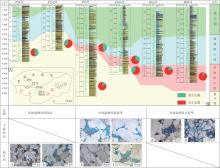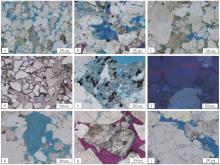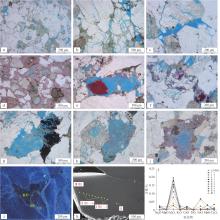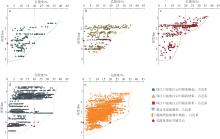

石油与天然气地质 ›› 2024, Vol. 45 ›› Issue (1): 44-64.doi: 10.11743/ogg20240104
远光辉1( ), 彭光荣2,3, 张丽丽2,3, 孙辉2,3, 陈淑慧2,3, 刘浩2,3, 赵晓阳1
), 彭光荣2,3, 张丽丽2,3, 孙辉2,3, 陈淑慧2,3, 刘浩2,3, 赵晓阳1
收稿日期:2024-02-19
修回日期:2024-02-22
出版日期:2024-02-01
发布日期:2024-02-29
第一作者简介:远光辉(1986—),男,博士、教授,油气储层地质学和沉积盆地地质流体-岩石相互作用。E-mail: yuan.guanghui@upc.edu.cn。
基金项目:
Guanghui YUAN1( ), Guangrong PENG2,3, Lili ZHANG2,3, Hui SUN2,3, Shuhui CHEN2,3, Hao LIU2,3, Xiaoyang ZHAO1
), Guangrong PENG2,3, Lili ZHANG2,3, Hui SUN2,3, Shuhui CHEN2,3, Hao LIU2,3, Xiaoyang ZHAO1
Received:2024-02-19
Revised:2024-02-22
Online:2024-02-01
Published:2024-02-29
摘要:
珠江口盆地白云凹陷油气勘探逐渐从中-浅层韩江组-珠江组的常规储层转向深层-超深层珠海组-恩平组的低渗致密储层,特殊的高变地温地质背景使得储层成岩作用以及致密化机制与常规储层差别较大。综合运用铸体薄片鉴定、扫描电镜观察、物性测试、成岩过程重建和物性恢复等技术,系统分析了白云凹陷西北部低隆起-中部洼陷带古近系珠海组下段-恩平组砂岩储层的成岩过程及差异,结合构造演化背景、地层埋藏史和现今物性数据,研究了影响储层物性关系的主要因素以及储层致密化过程与机理。结果表明:珠海组下段-恩平组储层经历了较强的压实作用、2期碳酸盐胶结、3期硅质胶结和3期长石溶解作用。储层成岩作用过程中,地温梯度变化导致压实速率不同,经历不同开放-封闭体系的水-岩反应过程是不同区带物性差异的主要原因。压实作用是导致储层致密的主要因素,硅质胶结和碳酸盐胶结进一步增强了储层致密程度,溶解作用改善了储层物性。从低隆起到洼陷带,伴随地温梯度升高和埋藏深度增加,低隆起储层成岩阶段为中成岩A2期,斜坡带为中成岩B期,洼陷带为晚成岩期,成岩强度不断增加;成岩作用的差异使得储层物性演化显著不同。洼陷带储层在晚期烃类充注前已致密化,斜坡带储层在晚期烃类充注阶段逐渐致密,而低隆起区储层目前仍为低渗储层。斜坡带整体埋深小于5 km,且上覆地层具备良好封盖能力,是下部勘探的重点。
中图分类号:

图4
白云凹陷珠海组下段-恩平组储层典型储集空间特征A.剖面位置;B.储层孔隙类型分布连井剖面;a. P27C井,埋深3 714.2 m,恩平组,原生粒间孔发育;b. P26井,埋深3 963.5 m,恩平组,粒间溶孔;c. P34A井,埋深4 407.1 m,珠海组下段,长石颗粒溶孔;d. P34A井,埋深4 407.1 m,珠海组下段,原生粒间孔;e. P33井,埋深5 092.5 m,恩平组,微裂缝;f. P25C井,埋深4 611.4 m,恩平组,凝灰质溶孔;g. B5A井,埋深5 109.0 m,珠海组下段,粒内溶孔,且有铁白云石粒内胶结;h. B5B井,埋深5 116.0 m,珠海组下段[a—h均为铸体薄片(-)显微照片。]"


图7
白云凹陷低隆起珠海组下段-恩平组储层典型成岩作用特征显微照片a. P26井,埋深3 515.5 m,珠海组下段,颗粒之间点接触、点-线接触,弱压实;b. P27B井,珠海组下段,埋深3 555.8 m,塑性矿物变形程度低;c. P26井,埋深4 125.0 m,恩平组,颗粒之间线接触;d. P26-A井,埋深3 428.5 m,珠海组下段,粒间方解石胶结;e. P27A井,埋深4 629.5 m,恩平组,铁白云石充填长石溶孔;f. P26井,埋深3 428.5 m,珠海组下段,石英加大边;g. P26井,埋深4 267.2 m,长石铸模孔;h. P27B井,埋深4 148.0 m,恩平组,岩屑溶蚀;i. P27A,埋深4 149.8 m,恩平组,石英加大边溶解[f为阴极发光;其余均为铸体薄片(-)。]"


图8
白云凹陷斜坡带珠海组下段-恩平组储层典型成岩作用及自生石英微量元素特征a. P34A井,埋深4 289.8 m,珠海组下段,石英颗粒线-凹凸接触,中强压实;b. P34A井,恩平组,埋深4 350.0 m,石英颗粒微裂缝;c. P34A井,埋深4 542.2 m,恩平组,石英加大边、自生石英;d. P34A井,埋深4 256.0 m,珠海组下段,方解石基底式胶结;e. P34A井,埋深4 347.0 m,恩平组,方解石充填长石溶孔;f. P34A井,4 289.8 m,珠海组下段,铁方解石交代方解石;g. P34A井,埋深4395.3 m,恩平组,黄铁矿胶结;h. P34A井,埋深4 595.0 m,恩平组,长石溶蚀形成铸模孔;i. P25C井,埋深4 287.4 m,恩平组,凝灰质溶孔;j. P34A井,埋深4 407.1 m,恩平组,3期石英加大边;k. P34A井,埋深4 407.1 m,恩平组,3期石英加大边打点位置;l. 3期硅质胶结电子探针微量元素特征[a—i为铸体薄片(-)显微照片;j为阴极发光照片;k为扫描电镜照片。]"


图9
白云凹陷洼陷带珠海组下段-恩平组储层典型成岩作用特征显微照片a. B5A,埋深4 791.1 m,珠海组下段,塑性颗粒挤压变形,压实;b. B5B,埋深5 167.0 m,恩平组,石英颗粒破裂缝,强压实;c. P36A,埋深3 620.4 m,珠海组下段,铁白云石充填溶孔;d. B5A,埋深4 647.4 m,珠海组下段,白云石交代长石;e. B5A,埋深4 634.9 m,珠海组下段,团块状菱铁矿胶结物;f. B5B,埋深5 188.0 m,恩平组,石英加大边;g. P36A,埋深3 778.0 m,珠海组下段,铁白云石交代高岭石;h. P36A,埋深3 780.0 m,珠海组下段,长石铸模孔;i. B5B,埋深5 116.0 m,石英颗粒溶解[f为阴极发光;其余均为铸体薄片(-)。]"


图11
地温场对储层孔隙度的影响a. 珠江口盆地白云凹陷低隆起孔隙度-深度关系,地温梯度30 ~ 35 ℃/km,均值34 ℃/km;b. 珠江口盆地白云凹陷斜坡带孔隙度-深度关系,地温梯度35 ~ 42 ℃/km,均值39 ℃/km;c. 珠江口盆地白云凹陷洼陷带孔隙度-深度关系,地温梯度40 ~ 45 ℃/km,均值43 ℃/km;d. 柴达木盆地腹部孔隙度-深度关系,据郭佳佳等(2018)修改[49] ,地温梯度20 ~ 30 ℃/km,均值27 ℃/km;e. 渤海湾盆地冀中坳陷孔隙度-深度关系,据葸克来等(2014)修改[50] ,地温梯度20 ~ 40 ℃/km,均值32 ℃/km"

表1
白云凹陷珠海组下段-恩平组储层成岩作用过程孔隙度变化"
| 区带 | 井号 | 深度/m |   |   |     |   |   |   |   |
|---|---|---|---|---|---|---|---|---|---|
| 低隆起 | P26 | 3 963.5 ~ 4 267.2 | 3.2 | 6.1 | 3.1 | 6.7 | 5.0 | 11.2 | 24.4 |
| 低隆起 | P27B | 4 142.4 ~ 4 631.5 | 3.6 | 7.1 | 2.7 | 5.8 | 4.5 | 10.3 | 23.4 |
| 低隆起 | P27C | 3 555.8 ~ 3 971.5 | 1.5 | 3.3 | 3.5 | 7.3 | 6.5 | 12.7 | 26.3 |
| 斜坡带 | P25B | 3 925.4 ~ 4 388.4 | 2.2 | 4.5 | 3.1 | 6.8 | 4.6 | 10.5 | 26.8 |
| 斜坡带 | P33 | 4 299.0 ~ 5 094.0 | 0.9 | 1.9 | 3.5 | 7.1 | 4.8 | 11.2 | 29.0 |
| 斜坡带 | P34 | 4 289.8 ~ 4 595.0 | 1.9 | 3.8 | 3.8 | 7.2 | 5.1 | 11.9 | 26.5 |
| 洼陷带 | B5A | 4 710.5 ~ 4 811.1 | 0.9 | 1.9 | 3.3 | 6.5 | 3.9 | 8.2 | 31.4 |
| 洼陷带 | B5B | 5 107.0 ~ 5 188.0 | 1.1 | 2.2 | 2.7 | 5.2 | 3.1 | 6.3 | 31.7 |
| 1 | 冯佳睿, 高志勇, 崔京钢, 等. 深层、超深层碎屑岩储层勘探现状与研究进展[J]. 地球科学进展, 2016, 31(7): 718-736. |
| FENG Jiarui, GAO Zhiyong, CUI Jinggang, et al. The exploration status and research advances of deep and ultra-deep clastic reservoirs[J]. Advances in Earth Science, 2016, 31(7): 718-736. | |
| 2 | 贾承造, 庞雄奇. 深层油气地质理论研究进展与主要发展方向[J]. 石油学报, 2015, 36(12): 1457-1469. |
| JIA Chengzao, PANG Xiongqi. Research processes and main development directions of deep hydrocarbon geological theories[J]. Acta Petrolei Sinica, 2015, 36(12): 1457-1469. | |
| 3 | 李阳, 薛兆杰, 程喆, 等. 中国深层油气勘探开发进展与发展方向[J]. 中国石油勘探, 2020, 25(1): 45-57. |
| LI Yang, XUE Zhaojie, CHENG Zhe, et al. Progress and development directions of deep oil and gas exploration and development in China[J]. China Petroleum Exploration, 2020, 25(1): 45-57. | |
| 4 | 张光亚, 马锋, 梁英波, 等. 全球深层油气勘探领域及理论技术进展[J]. 石油学报, 2015, 36(9): 1156-1166. |
| ZHANG Guangya, MA Feng, LIANG Yingbo, et al. Domain and theory-technology progress of global deep oil & gas exploration[J]. Acta Petrolei Sinica, 2015, 36(9): 1156-1166. | |
| 5 | 孙龙德, 邹才能, 朱如凯, 等. 中国深层油气形成、分布与潜力分析[J]. 石油勘探与开发, 2013, 40(6): 641-649. |
| SUN Longde, ZOU Caineng, ZHU Rukai, et al. Formation, distribution and potential of deep hydrocarbon resources in China[J]. Petroleum Exploration and Development, 2013, 40(6): 641-649. | |
| 6 | 何登发, 马永生, 刘波, 等. 中国含油气盆地深层勘探的主要进展与科学问题[J]. 地学前缘, 2019, 26(1): 1-12. |
| HE Dengfa, MA Yongsheng, LIU Bo, et al. Main advances and key issues for deep-seated exploration in petroliferous basins in China[J]. Earth Science Frontiers, 2019, 26(1): 1-12. | |
| 7 | 操应长, 远光辉, 杨海军, 等. 含油气盆地深层—超深层碎屑岩油气勘探现状与优质储层成因研究进展[J]. 石油学报, 2022, 43(1): 112-140. |
| CAO Yingchang, YUAN Guanghui, YANG Haijun, et al. Current situation of oil and gas exploration and research progress of the origin of high-quality reservoirs in deep-ultra-deep clastic reservoirs of petroliferous basins[J]. Acta Petrolei Sinica, 2022, 43(1): 112-140. | |
| 8 | 米立军, 柳保军, 何敏, 等. 南海北部陆缘白云深水区油气地质特征与勘探方向[J]. 中国海上油气, 2016, 28(2): 10-22. |
| MI Lijun, LIU Baojun, HE Min, et al. Petroleum geology characteristics and exploration direction in Baiyun deep water area, northern continental margin of the South China Sea[J]. China Offshore Oil and Gas, 2016, 28(2): 10-22. | |
| 9 | 庞雄, 申俊, 袁立忠, 等. 南海珠江深水扇系统及其油气勘探前景[J]. 石油学报, 2006, 27(3): 11-15, 21. |
| PANG Xiong, SHEN Jun, YUAN Lizhong, et al. Petroleum prospect in deep-water fan system of the Pearl River in the South China Sea[J]. Acta Petrolei Sinica, 2006, 27(3): 11-15, 21. | |
| 10 | 田立新, 张忠涛, 庞雄, 等. 白云凹陷中深层超压发育特征及油气勘探新启示[J]. 中国海上油气, 2020, 32(6): 1-11. |
| TIAN Lixin, ZHANG Zhongtao, PANG Xiong, et al. Characteristics of overpressure development in the mid-deep strata of Baiyun Sag and its new enlightenment in exploration activity[J]. China Offshore Oil and Gas, 2020, 32(6): 1-11. | |
| 11 | 张功成, 李友川, 刘世翔, 等. “源热共控” 中国海油气田 “近岸油、远岸气” 有序分布[J]. 中国石油勘探, 2014, 19(5): 1-22. |
| ZHANG Gongcheng, LI Youchuan, LIU Shixiang, et al. “Co-Control of source rock and heat” in orderly distribution of “near-shore oil and far-shore gas” in China’s offshore and adjacent area[J]. China Petroleum Exploration, 2014, 19(5): 1-22. | |
| 12 | 张功成, 杨海长, 陈莹, 等. 白云凹陷——珠江口盆地深水区一个巨大的富生气凹陷[J]. 天然气工业, 2014, 34(11): 11-25. |
| ZHANG Gongcheng, YANG Haichang, CHEN Ying, et al. The Baiyun Sag: A giant rich gas-generation sag in the deepwater area of the Pearl River Mouth Basin[J]. Natural Gas Industry, 2014, 34(11): 11-25. | |
| 13 | 朱伟林. 南海北部深水区油气地质特征[J]. 石油学报, 2010, 31(4): 521-527. |
| ZHU Weilin. Petroleum geology in deepwater area of northern continental margin in South China Sea[J]. Acta Petrolei Sinica, 2010, 31(4): 521-527. | |
| 14 | 廖计华, 吴克强, 耳闯. 珠江口盆地白云凹陷深层储层特征与有效储层控制因素[J]. 地球科学, 2022, 47(7): 2454-2467. |
| LIAO Jihua, WU Keqiang, Chuang ER. Deep reservoir characteristics and effective reservoir control factors in Baiyun Sag of Pearl River Mouth Basin[J]. Earth Science, 2022, 47(7): 2454-2467. | |
| 15 | 吕成福, 陈国俊, 张功成, 等. 珠江口盆地白云凹陷珠海组碎屑岩储层特征及成因机制[J]. 中南大学学报(自然科学版), 2011, 42(9): 2763-2773. |
| Chengfu LYU, CHEN Guojun, ZHANG Gongcheng, et al. Reservoir characteristics of detrital sandstones in Zhuhai Formation of Baiyun Sag, Pearl River Mouth Basin[J]. Journal of Central South University, 2011, 42(9): 2763-2773. | |
| 16 | 潘光超, 周家雄, 韩光明, 等. 中深层 “甜点” 储层地震预测方法探讨——以珠江口盆地西部文昌A凹陷为例[J]. 岩性油气藏, 2016, 28(1): 94-100. |
| PAN Guangchao, ZHOU Jiaxiong, HAN Guangming, et al. Seismic prediction method of “sweet” reservoir in middle-deep zone: A case study from Wenchang A Sag, western Pearl River Mouth Basin[J]. Lithologic Reservoirs, 2016, 28(1): 94-100. | |
| 17 | 庞雄, 施和生, 朱明, 等. 再论白云深水区油气勘探前景[J]. 中国海上油气, 2014, 26(3): 23-29. |
| PANG Xiong, SHI Hesheng, ZHU Ming, et al. A further discussion on the hydrocarbon exploration potential in Baiyun deep water area[J]. China Offshore Oil and Gas, 2014, 26(3): 23-29. | |
| 18 | 文静, 赵靖舟, 李军, 等. 白云凹陷中深层古近系砂岩储层特征及溶蚀作用对优质储层的控制作用[J]. 特种油气藏, 2022, 29(6): 47-55. |
| WEN Jing, ZHAO Jingzhou, LI Jun, et al. Characteristics of mid-deep Paleogene sandstone reservoirs in Baiyun Sag and controlling effect of dissolution on high-quality reservoirs[J]. Special Oil & Gas Reservoirs, 2022, 29(6): 47-55. | |
| 19 | 高阳东, 彭光荣, 张向涛, 等. 珠江口盆地白云凹陷古近系文昌组源-汇系统特征及演化[J]. 石油与天然气地质, 2023, 44(3): 584-599. |
| GAO Yangdong, PENG Guangrong, ZHANG Xiangtao, et al. Characteristics and evolution of the source-to-sink system of the Paleogene Wenchang Formation in Baiyun Sag, Pearl River Mouth Basin[J]. Oil & Gas Geology, 2023, 44(3): 584-599. | |
| 20 | 彭光荣, 王绪诚, 陈维涛, 等. 珠江口盆地惠州26洼东南缘古近系恩平组上段断-拗转换期源-汇系统及勘探意义[J]. 石油与天然气地质, 2023, 44(3): 613-625. |
| PENG Guangrong, WANG Xucheng, CHEN Weitao, et al. Source-to-sink system during rifting-depression transition period and its exploration significance: A case study of the Upper Enping Formation at southeastern margin of Huizhou 26 sub-sag, Pearl River Mouth Basin[J]. Oil & Gas Geology, 2023, 44(3): 613-625. | |
| 21 | 操应长, 远光辉, 王艳忠, 等. 典型含油气盆地深层富长石碎屑岩储层长石溶蚀接力成孔认识及其油气地质意义[J]. 中国科学: 地球科学, 2022, 52(9): 1694-1725. |
| CAO Yingchang, YUAN Guanghui, WANG Yanzhong, et al. Understanding of feldspar dissolution relay pore formation in deep feldspar rich clastic rock reservoirs of typical oil and gas bearing basins and its geological significance for oil and gas exploration[J]. Science China: Earth Sciences, 2022, 52(9): 1694-1725. | |
| 22 | 高志勇, 王晓琦, 李建明, 等. 库车坳陷克拉苏构造带白垩系储层孔喉组合类型定量表征与展布[J]. 石油学报, 2018, 39(6): 645-659. |
| GAO Zhiyong, WANG Xiaoqi, LI Jianming, et al. Quantitative characterization and distribution of pore throat assemblages of Cretaceous reservoir in the Kelasu tectonic belt, Kuqa Depression[J]. Acta Petrolei Sinica, 2018, 39(6): 645-659. | |
| 23 | 胡圣标, 龙祖烈, 朱俊章, 等. 珠江口盆地地温场特征及构造-热演化[J]. 石油学报, 2019, 40(): 178-187. |
| HU Shengbiao, LONG Zulie, ZHU Junzhang, et al. Characteristics of geothermal field and the tectonic-thermal evolution in Pearl River Mouth Basin[J]. Acta Petrolei Sinica, 2019, 40(S1): 178-187. | |
| 24 | 黄玉平, 龙祖烈, 朱俊章, 等. 珠江口盆地白云凹陷地温场特征及烃源岩热演化[J]. 现代地质, 2022, 36(1): 130-139. |
| HUANG Yuping, LONG Zulie, ZHU Junzhang, et al. Geothermal field characteristics and maturity history of source rocks in Baiyun Sag, Pearl River Estuary Basin[J]. Geoscience, 2022, 36(1): 130-139. | |
| 25 | 刘豪, 徐长贵, 高阳东, 等. 断陷湖盆低勘探区源-汇系统与烃源岩预测——以珠江口盆地珠一坳陷北部洼陷区为例[J]. 石油与天然气地质, 2023, 44(3): 565-583. |
| LIU Hao, XU Changgui, GAO Yangdong, et al. Source-to-sink system and hydrocarbon source rock prediction of underexplored areas in rifted lacustrine basins: A case study on northern lows in Zhu Ⅰ Depression, Pearl River Mouth Basin[J]. Oil & Gas Geology, 2023, 44(3): 565-583. | |
| 26 | 李弛, 罗静兰, 胡海燕, 等. 热动力条件对白云凹陷深水区珠海组砂岩成岩演化过程的影响[J]. 地球科学, 2019, 44(2): 572-587. |
| LI Chi, LUO Jinglan, HU Haiyan, et al. Thermodynamic impact on deepwater sandstone diagenetic evolution of Zhuhai Formation in Baiyun Sag, Pearl River Mouth Basin[J]. Earth Science, 2019, 44(2): 572-587. | |
| 27 | 雷川. 珠江口盆地白云凹陷高热背景对深水区储层质量的影响[D]. 西安: 西北大学, 2019. |
| LEI Chuan. Influence of high thermal background on deep water reservoir quality in the Baiyun Sag, Pearl River Mouth Basin[D]. Xi’an: Northwest University, 2019. | |
| 28 | 袁静, 周涛, 乔俊, 等. 深层砂砾岩中的深部热流体作用及其地质意义——以渤海湾盆地东营凹陷民丰—盐家地区古近系沙河街组四段为例[J]. 石油与天然气地质, 2022, 43(4): 929-942. |
| YUAN Jing, ZHOU Tao, QIAO Jun, et al. Deep hydrothermalism of deep coarse-grained siliciclastic rocks and its geological significance: A case study of the 4th member of the Paleogene Shahejie Formation in Minfeng-Yanjia area, Dongying Sag, Bohai Bay Basin[J]. Oil & Gas Geology, 2022, 43(4): 929-942. | |
| 29 | 曹江骏. 异常高压背景下成岩流体活动对储层成岩-孔隙演化的影响——以莺歌海盆地乐东X区中深层砂岩储层为例[D]. 西安: 西北大学, 2022. |
| CAO Jiangjun. Diagenetic fluid activity and its influence on diagenesis-pore evolution of the reservoir under abnormally high pressure background: A case study of the medium-deep buried sandstone reservoir in the Ledong X area of the Yinggehai Basin, the Northern South[D]. Xi’an: Northwest University, 2022. | |
| 30 | 陈淑慧, 彭光荣, 张丽, 等. 南海北部白云深水区高变地温梯度砂岩渗透率定量预测[J]. 地球科学, 2022, 47(7): 2468-2480. |
| CHEN Shuhui, PENG Guangrong, ZHANG Li, et al. Quantitative prediction of permeability of high variable geothermal gradient sandstone in Baiyun deep water area of northern South China Sea[J]. Editorial Committee of Earth Science-Journal of China University of Geosciences, 2022, 47(7): 2468-2480. | |
| 31 | 钟大康, 朱筱敏, 王红军. 中国深层优质碎屑岩储层特征与形成机理分析[J]. 中国科学:地球科学, 2008, 38(): 11-18. |
| ZHONG Dakang, ZHU Xiaomin, WANG Hongjun. 外文标题缺失[J]. Science China: Earth Sciences, 2008, 38(S1): 11-18. | |
| 32 | 徐强, 王英民, 吕明, 等. 陆架边缘三角洲在层序地层格架中的识别及其意义——以南海白云凹陷为例[J]. 石油与天然气地质, 2011, 32(5): 733-742. |
| XU Qiang, WANG Yingmin, Ming LYU, et al. Identification of the shelf margin delta in sequence stratigraphic frameworks and its significance: A case study of the Baiyun Sag, South China Sea[J]. Oil & Gas Geology, 2011, 32(5): 733-742. | |
| 33 | 徐小童, 张立宽, 冶明泽, 等. 深层砂岩储层成岩作用差异性及与储层质量的关系——以准噶尔盆地中部征沙村地区侏罗系为例[J]. 天然气地球科学, 2021, 32(7): 1022-1036. |
| XU Xiaotong, ZHANG Likuan, YE Mingze, et al. Different diagenesis of deep sandstone reservoir and its relationship with reservoir property :Case study of Jurassic in Zhengshacun area, central Junggar Basin[J]. Natural Gas Geoscience, 2021, 32(7): 1022-1036. | |
| 34 | 庞雄, 任建业, 郑金云, 等. 陆缘地壳强烈拆离薄化作用下的油气地质特征——以南海北部陆缘深水区白云凹陷为例[J]. 石油勘探与开发, 2018, 45(1): 27-39. |
| PANG Xiong, REN Jianye, ZHENG Jinyun, et al. Petroleum geology controlled by extensive detachment thinning of continental margin crust: A case study of Baiyun Sag in the deep-water area of northern South China Sea[J]. Petroleum Exploration and Development, 2018, 45(1): 27-39. | |
| 35 | 柳保军, 庞雄, 谢世文, 等. 珠江口盆地白云凹陷壳幔拆离断裂活动对深层大型三角洲沉积体系的控制作用[J]. 地球科学, 2022, 47(7): 2354-2373. |
| LIU Baojun, PANG Xiong, XIE Shiwen, et al. Control effect of crust-mantle detachment fault activity on deep large delta sedimentary system in Baiyun Sag, Pearl River Mouth Basin[J]. Earth Science, 2022, 47(7): 2354-2373. | |
| 36 | 罗静兰, 何敏, 庞雄, 等. 珠江口盆地南部热演化事件与高地温梯度的成岩响应及其对油气勘探的启示[J]. 石油学报, 2019, 40(): 90-104. |
| LUO Jinglan, HE Min, PANG Xiong, et al. Diagenetic response on thermal evolution events and high geothermal gradients in the southern Pear River Mouth Basin and its enlightenment to hydrocarbon exploration[J]. Acta Petrolei Sinica, 2019, 40(S1): 90-104. | |
| 37 | 米立军, 张忠涛, 庞雄, 等. 南海北部陆缘白云凹陷油气富集规律及主控因素[J]. 石油勘探与开发, 2018, 45(5): 902-913. |
| MI Lijun, ZHANG Zhongtao, PANG Xiong, et al. Main controlling factors of hydrocarbon accumulation in Baiyun Sag at northern continental margin of South China Sea[J]. Petroleum Exploration and Development, 2018, 45(5): 902-913. | |
| 38 | 庞雄, 陈长民, 陈红汉, 等. 白云深水区油气成藏动力条件研究[J]. 中国海上油气, 2008, 20(1): 9-14. |
| PANG Xiong, CHEN Changmin, CHEN Honghan, et al. A study on hydrocarbon accumulation dynamics in Baiyun deep-water area, Pearl River Mouth Basin[J]. China Offshore Oil and Gas, 2008, 20(1): 9-14. | |
| 39 | 赵玉娟, 杨香华, 朱红涛, 等. 白云凹陷古近系恩平组沉积背景差异及其烃类特征[J]. 地质科技情报, 2017, 36(3): 156-163. |
| ZHAO Yujuan, YANG Xianghua, ZHU Hongtao, et al. Distinct sedimentary backgrounds and hydrocarbon characteristics of Paleogene Enping Formation, Baiyun Sag[J]. Geological Science and Technology Information, 2017, 36(3): 156-163. | |
| 40 | 李成海, 王家豪, 柳保军, 等. 珠江口盆地白云凹陷古近系沉积相类型[J]. 沉积学报, 2014, 32(6): 1162-1170. |
| LI Chenghai, WANG Jiahao, LIU Baojun, et al. Types and distribution of the Paleogene sedimentary facies in Baiyun Depression of Pearl River Mouth Basin[J]. Acta Sedimentologica Sinica, 2014, 32(6): 1162-1170. | |
| 41 | YUAN Guanghui, CAO Yingchang, GLUYAS J, et al. Petrography, fluid-inclusion, isotope, and trace-element constraints on the origin of quartz cementation and feldspar dissolution and the associated fluid evolution in arkosic sandstones[J]. AAPG Bulletin, 2018, 102(5): 761-792. |
| 42 | 杨海长, 陈莹, 纪沫, 等. 珠江口盆地深水区构造演化差异性与油气勘探意义[J]. 中国石油勘探, 2017, 22(6): 59-68. |
| YANG Haichang, CHEN Ying, JI Mo, et al. Structural evolution difference and the significance for oil and gas exploration in the deep water area of the Pearl River Mouth Basin[J]. China Petroleum Exploration, 2017, 22(6): 59-68. | |
| 43 | ZHAO Fang, ALVES T M, WU Shiguo, et al. Prolonged post-rift magmatism on highly extended crust of divergent continental margins (Baiyun Sag, South China Sea)[J]. Earth and Planetary Science Letters, 2016, 445: 79-91. |
| 44 | 曹江骏, 罗静兰, 范彩伟, 等. 深部热流体活动对储层成岩作用及孔隙演化的影响:以莺歌海盆地LDX区中新统黄流组为例[J]. 地学前缘, 2022, 29(4): 412-429. |
| CAO Jiangjun, LUO Jinglan, FAN Caiwei, et al. Deep thermal fluid activity and its influence on the diagenesis and pore evolution of reservoirs: A case study from the Miocene Huangliu Formation reservoir in the LDX area, Yinggehai Basin, northern South China Sea[J]. Earth Science Frontiers, 2022, 29(4): 412-429. | |
| 45 | 袁静, 周涛, 赵广昊. 深部热流体活动的识别标志及其对储层的改造作用[J]. 地质学报, 2023, 97(6): 2067-2083. |
| YUAN Jing, ZHOU Tao, ZHAO Guanghao. Identification marks of deep thermal fluid activity and its effect on reservoir transformation[J]. Acta Geologica Sinica, 2023, 97(6): 2067-2083. | |
| 46 | 金之钧, 杨雷, 曾溅辉, 等. 东营凹陷深部流体活动及其生烃效应初探[J]. 石油勘探与开发, 2002, 29(2): 42-44. |
| JIN Zhijun, YANG Lei, ZENG Jianhui, et al. Deep fluid activities and their effects on generation of hydrocarbon in Dongying Depression[J]. Petroleum Exploration and Development, 2002, 29(2): 42-44. | |
| 47 | 寿建峰, 张惠良, 斯春松, 等. 砂岩动力成岩作用[M]. 北京: 石油工业出版社, 2005: 153. |
| SHOU Jianfeng, ZHANG Huiliang, SI Chunsong, et al. Sandstone dynamic diagenesis[M]. Beijing: Petroleum Industry Press, 2005: 153. | |
| 48 | 曹江骏, 罗静兰, 马迪娜·马吾提汗, 等. 差异性沉积—成岩演化过程对砂砾岩储层致密化的影响——以准噶尔盆地东部二叠系上乌尔禾组为例[J]. 中国矿业大学学报, 2022, 51(5): 923-940. |
| CAO Jiangjun, LUO Jinglan, Ma Di Na-Ma Wu Di Han, et al. Influence of differential sedimentary-diagenetic evolution on the densification of the sandy conglomerate reservoir: A case study of the Permian Upper Wuerhe formation in eastern Junggar Basin[J]. Journal of China University of Mining & Technology, 2022, 51(5): 923-940. | |
| 49 | 郭佳佳, 孙国强, 门宏建, 等. 柴北缘腹部深层异常高孔—渗储层成因分析[J]. 沉积学报, 2018, 36(4): 777-786. |
| GUO Jiajia, SUN Guoqiang, Hongjian MEN, et al. Genetic analysis of anomalously high porosity zones in deeply buried reservoirs in the west part of northern edge of Qaidam Basin, NW China[J]. Acta Sedimentologica Sinica, 2018, 36(4): 777-786. | |
| 50 | 葸克来, 操应长, 金杰华, 等. 冀中坳陷霸县凹陷古近系中深层古地层压力演化及对储层成岩作用的影响[J]. 石油学报, 2014, 35(5): 867-878. |
| XI Kelai, CAO Yingchang, JIN Jiehua, et al. Paleopressure evolution and its effects on diagenesis of reservoirs in middle-deep Paleogene strata in Baxian Sag, Jizhong Depression[J]. Acta Petrolei Sinica, 2014, 35(5): 867-878. | |
| 51 | 丁茜, 王静彬, 杨磊磊, 等. 基于模拟实验探讨断裂-流体-岩石体系中的矿物溶解-沉淀过程[J]. 石油与天然气地质, 2023, 44(1): 164-177. |
| DING Qian, WANG Jingbin, YANG Leilei, et al. Exploring the mineral dissolution-precipitation processes in fracture-fluid-rock systems based on simulation experiments[J]. Oil & Gas Geology, 2023, 44(1): 164-177. | |
| 52 | 袁静, 周涛, 景安语, 等. 断陷湖盆斜坡带储层差异性成岩—成储模式——以渤海湾盆地埕北低凸起东部斜坡带东营组为例[J]. 沉积学报, 2023, 41(3): 804-817. |
| YUAN Jing, ZHOU Tao, JING Anyu, et al. Differential diagenesis-reservoir formation model of the slope belt of a faulted lacustrine basin: Case study of the Dongying Formation in the eastern slope belt of the Chengbei low uplift, Bohai Bay Basin[J]. Acta Sedimentologica Sinica, 2023, 41(3): 804-817. | |
| 53 | BEARD D C, WEYL P K. Influence of texture on porosity and permeability of unconsolidated sand[J]. AAPG Bulletin, 1973, 57(2): 349-369. |
| 54 | 王艳忠, 操应长, 葸克来, 等. 碎屑岩储层地质历史时期孔隙度演化恢复方法——以济阳坳陷东营凹陷沙河街组四段上亚段为例[J]. 石油学报, 2013, 34(6): 1100-1111. |
| WANG Yanzhong, CAO Yingchang, XI Kelai, et al. A recovery method for porosity evolution of clastic reservoirs with geological time: A case study from the upper submember of ES4 in the Dongying depression, Jiyang Subbasin[J]. Acta Petrolei Sinica, 2013, 34(6): 1100-1111. | |
| 55 | 米立军, 何敏, 翟普强, 等. 珠江口盆地深水区白云凹陷高热流背景油气类型与成藏时期综合分析[J]. 中国海上油气, 2019, 31(1): 1-12. |
| MI Lijun, HE Min, ZHAI Puqiang, et al. Integrated study on hydrocarbon types and accumulation periods of Baiyun Sag, deep water area of Pearl River Mouth Basin under the high heat flow background[J]. China Offshore Oil and Gas, 2019, 31(1): 1-12. |
| [1] | 蒲秀刚, 董姜畅, 柴公权, 宋舜尧, 时战楠, 韩文中, 张伟, 解德录. 渤海湾盆地沧东凹陷古近系孔店组二段页岩高丰度有机质富集模式[J]. 石油与天然气地质, 2024, 45(3): 696-709. |
| [2] | 韩载华, 刘华, 赵兰全, 刘景东, 尹丽娟, 李磊. 渤海湾盆地临南洼陷古近系沙河街组源-储组合类型与致密(低渗)砂岩油差异富集模式[J]. 石油与天然气地质, 2024, 45(3): 722-738. |
| [3] | 高和群, 高玉巧, 何希鹏, 聂军. 苏北盆地古近系阜宁组二段页岩油储层岩石力学特征及其控制因素[J]. 石油与天然气地质, 2024, 45(2): 502-515. |
| [4] | 黎瑞, 杨娇, 柴愈坤, 王华, 戴建文, 邓永辉, 孙爽, 马肖琳, 田腾飞. 大角度波浪控制下的浪成砂坝新模式[J]. 石油与天然气地质, 2024, 45(2): 530-541. |
| [5] | 董鑫旭, 周兴海, 李昆, 蒲仁海, 王爱国, 关蕴文, 张鹏. 海上稀疏井区高精度地层格架约束下的地震沉积学刻画[J]. 石油与天然气地质, 2024, 45(1): 293-308. |
| [6] | 杨小艺, 刘成林, 王飞龙, 李国雄, 冯德浩, 杨韬政, 何志斌, 苏加佳. 渤海湾盆地渤中凹陷西南洼古近系东营组超压分布特征及成因[J]. 石油与天然气地质, 2024, 45(1): 96-112. |
| [7] | 方志雄, 肖秋生, 张殿伟, 段宏亮. 苏北盆地陆相“断块型”页岩油地质特征及勘探实践[J]. 石油与天然气地质, 2023, 44(6): 1468-1478. |
| [8] | 王永诗, 巩建强, 陈冬霞, 邱贻博, 茆书巍, 雷文智, 杨怀宇, 王翘楚. 渤海湾盆地东营凹陷盐家地区深层砂砾岩油气藏相态演化及成藏过程[J]. 石油与天然气地质, 2023, 44(5): 1159-1172. |
| [9] | 史玉玲, 龙祖烈, 张向涛, 温华华, 马晓楠. 珠江口盆地恩平凹陷恩平17洼油气动态成藏过程[J]. 石油与天然气地质, 2023, 44(5): 1279-1289. |
| [10] | 刘豪, 徐长贵, 高阳东, 林鹤鸣, 邱欣卫, 剧永涛, 汪旭东, 李磊, 孟俊, 阙晓明. 断陷湖盆低勘探区源-汇系统与烃源岩预测[J]. 石油与天然气地质, 2023, 44(3): 565-583. |
| [11] | 高阳东, 彭光荣, 张向涛, 汪旭东, 孙辉, 刘太勋, 孙丰春. 珠江口盆地白云凹陷古近系文昌组源-汇系统特征及演化[J]. 石油与天然气地质, 2023, 44(3): 584-599. |
| [12] | 刘军, 彭光荣, 郑金云, 蔡嵩, 朱定伟, 王梓颐. 珠江口盆地白云凹陷西区始新世张裂-拆离作用下沉积转换及源-汇响应[J]. 石油与天然气地质, 2023, 44(3): 600-612. |
| [13] | 彭光荣, 王绪诚, 陈维涛, 靳瑶瑶, 王菲, 王文勇, 全涵. 珠江口盆地惠州26洼东南缘古近系恩平组上段断-拗转换期源-汇系统及勘探意义[J]. 石油与天然气地质, 2023, 44(3): 613-625. |
| [14] | 王梓颐, 李洪博, 郑金云, 朱定伟, 于飒, 陈兆明, 李振升. 珠江口盆地番禺27洼裂陷期构造演化及其对源-汇系统的控制[J]. 石油与天然气地质, 2023, 44(3): 626-636. |
| [15] | 杜晓峰, 庞小军, 黄晓波, 王冰洁. 辽西凹陷北部古近系沙河街组二段源-汇系统及其对滩坝砂体的控制[J]. 石油与天然气地质, 2023, 44(3): 662-674. |
| 阅读次数 | ||||||||||||||||||||||||||||||||||||||||||||||||||
|
全文 144
|
|
|||||||||||||||||||||||||||||||||||||||||||||||||
|
摘要 168
|
|
|||||||||||||||||||||||||||||||||||||||||||||||||